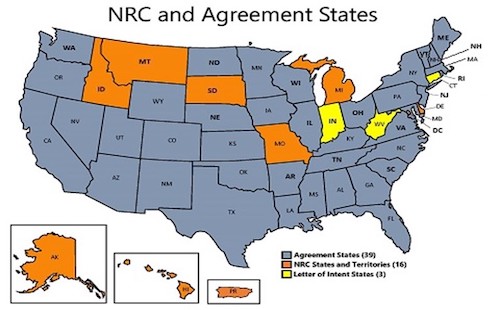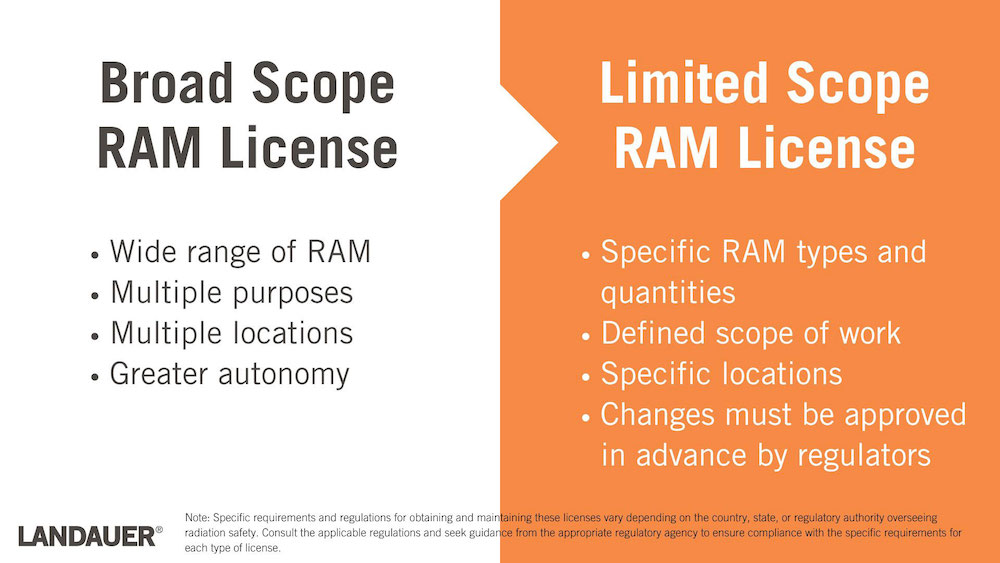
Understanding Your Radioactive Materials License
A Radioactive Materials License is an official authorization granted by a regulatory agency, such as the Nuclear Regulatory Commission (NRC), a State regulatory agency in the United States, or an equivalent regulatory body in other countries. The license allows individuals or organizations to possess, use, store, and handle radioactive materials (RAM) for specific purposes, such as research and development, diagnosis and therapy, training, industrial processes, or other approved activities.
Licenses for the use of RAM are issued after a thorough review of the applicant's qualifications, the design of their facilities, their radiation safety program(s), and the alignment of the application with relevant regulations. The Radioactive Materials License specifies:
- The types and quantities of RAM that can be possessed
- Where RAM can be used or stored
- Who can possess RAM
- Conditions for RAM use
- The safety measures, operational procedures, and record-keeping requirements needed to ensure radiation safety
- The Radiation Safety Officer
- For licenses limited in scope, lists those authorized to use RAM
Policies and procedures for license requirements are specified in federal or state regulations and in the documents that you have submitted with the license application.
History – The AEC, NRC, and the Agreement States
In the United States before 1975, the Atomic Energy Commission (AEC) both promoted and regulated the use of RAM. In the early 1970s, Congress perceived that the nuclear power industry was mature and sustainable. Therefore, the AEC was dissolved, and Congress established the NRC in 1974 as an independent regulatory agency (i.e., per the Energy Reorganization Act of 1974). The NRC licenses and regulates the non-military use of RAM to protect public health and safety, promote the common defense and security, and protect the environment (Source: US NRC).
 Section 274 of the Atomic Energy Act of 1954 allowed the states to enter into agreements with the AEC and subsequently the NRC. The Agreement State Program was established in 1959. The program allows states to sign agreements that give them limited regulatory authority. In 1962, the Commonwealth of Kentucky became the first state to enter into such an agreement with the AEC (i.e., Kentucky became an Agreement State).
Section 274 of the Atomic Energy Act of 1954 allowed the states to enter into agreements with the AEC and subsequently the NRC. The Agreement State Program was established in 1959. The program allows states to sign agreements that give them limited regulatory authority. In 1962, the Commonwealth of Kentucky became the first state to enter into such an agreement with the AEC (i.e., Kentucky became an Agreement State).
Links to the licensing authorities in Agreement States can be found at: https://scp.nrc.gov/
NRC and Agreement State Licenses
NRC and Agreement State licenses are similar. The NRC license application is NRC Form 313. Guidance for completing this form can be found in the NUREG-1556 series (i.e., Consolidated Guidance About Materials Licenses). There are 21 NUREG-1556 series guides that vary based on the scope and use of RAM. For example, guidance for limited-scope medical licenses (diagnosis and therapy) can be found in NUREG-1556, Volume 9, Revision 3 (Program-Specific Guidance About Medical Use Licenses).
Agreement State licenses are similar and often reference the NRC’s NUREG-1556 Series or similar model procedures to guide licensees in the preparation of their applications and management of their radiation safety programs. NRC licenses are issued on Form 374 (see example licenses at https://scp.nrc.gov/asletters/training/g-109_04_Self-Study_Sample_Licenses.pdf).
RAM licenses are typically organized as follows:
 Licensee Information: The license includes the name and physical address of the licensee, which can be an individual, a company, a research institution, or a medical facility.
Licensee Information: The license includes the name and physical address of the licensee, which can be an individual, a company, a research institution, or a medical facility.- Authorized RAM: The license lists the types and quantities of RAM that can be possessed and used. It may include specific isotopes, specific isotope activity limits, and/or concentration limits, and the names of the authorized individuals.
- Authorized Individuals: Authorized Users, Authorized Nuclear Pharmacists, or Authorized Medical Physicists by name along with the approved use. Broad-scope licenses will not list authorized users on the license itself. The licensee will maintain a separate list of authorized individuals along with the basis for approving them.
- Approved Use: The license specifies the permitted activities involving radioactive materials, such as storage, use, handling, manufacture, transportation, disposal, or any other specific purpose approved by the regulatory agency.
- Authorized Locations: The license designates the approved locations where RAM can be used and stored. This may include laboratories, hospitals, industrial facilities, or any other authorized premises.
- Radiation Safety Requirements: The license outlines the radiation safety measures and procedures that must be followed, contamination controls, shielding, waste management procedures, emergency response protocols; and for some industrial operations, the use and types of dosimeters. Remember that commitments in the license application are binding.
- Inspections and Reporting: The licensee is typically required to allow regulatory inspections and submit regular reports on radiation safety practices, incidents, and RAM quantities. This requirement is often stated in the letter from the regulator containing the license.
- Expiration and Renewal: The license has a specified duration, usually ranging from one to five years, after which it must be renewed. Renewal is assured by demonstrating continued compliance with regulatory requirements.
- Security Orders and Requirements: For licensees that possess radioactive sources of concern [see Title 10, Code of Federal Regulations (CFR), Part 37], the license may also specify compliance with “Increased Controls” including employee background checks, controlled access, surveillance, protection of sensitive information, etc.
- Tie-downs (e.g., compliance with statements, representations, and procedures made in any documents provided to the NRC or Agreement State regulators): These documents are listed in the license and binding upon the licensee.
- Signatures: The license must be signed and dated by the NRC, an Agreement State regulator, or their authorized representative.
It is important for individuals or organizations holding a RAM license to strictly adhere to the license conditions and commitments made in the license application, maintain appropriate radiation safety programs, and conduct periodic training and self-assessments to ensure regulatory compliance. Violations of the license conditions can lead to penalties, fines, or revocation of the license, as well as potential harm to human health and/or the environment.

Broad-Scope Versus Limited-Scope Radioactive Materials Licenses
The most common type of license is the limited-scope license. The main differences between broad-scope and limited-scope licenses are the extent of authorized activities and the range of radioactive materials covered. Broad-scope licenses offer more flexibility and allow for a broader range of operations, whereas limited-scope licenses are focused and restricted to specific applications. A broad-scope licensee also has more autonomy than a limited-scope licensee.
Broad-Scope Licenses
A broad-scope radioactive materials license allows the licensee to possess, use, and distribute a wide range of RAM for various purposes. It also authorizes a comprehensive range of activities involving RAM, including handling, storage, processing, and disposal.
Broad-scope licensees typically deal with a diverse array of RAM and may use it for multiple purposes (e.g., diagnosis and therapy, research, and training). Broad-scope licensees often use RAM at multiple laboratories or facilities. Greater autonomy is typically granted to broad-scope licensees to approve new RAM users, open new use-areas, and approve new research.
Broad-scope licensees must keep the NRC or Agreement-State regulators informed of their actions. But unlike limited-scope licenses, they often don’t need to ask for approval from their regulatory agency. Changes in RAM use, RAM use areas, Authorized Users, etc. are reviewed and approved by the organization’s Radiation Safety Committee or Safety Committee and documented in meeting minutes to demonstrate regulatory compliance for regulatory inspectors.
Limited-Scope Licenses
Limited-scope RAM licenses provide authorization for a specific set of activities involving RAM. This type of license restricts the licensee to a defined scope of work, such as a particular radionuclide, activity level, or use. Limited-scope licenses are usually granted for specific purposes, such as medical diagnostic procedures, industrial uses, or research activities.
The license may specify the types and quantities of RAM that can be used, as well as the locations and conditions under which they can be handled. Authorized Users, new use areas, and changes in RAM use or possession limits must be approved by NRC or Agreement-State regulators in advance of their use of RAM or use in a new area.
Note: Specific requirements and regulations for obtaining and maintaining these licenses vary depending on the country, state, or regulatory authority overseeing radiation safety. Consult the applicable regulations and seek guidance from the appropriate regulatory agency to ensure compliance with the specific requirements for each type of license.
Radioactive Materials License Tie-Downs
Upon approval of the initial RAM license or renewal, the only document “tied down” to the license will be the application or renewal packet of policies and procedures that were submitted with the application or renewal. Each letter, facsimile, or other document submitted to the applicable regulator concerning the use of licensed RAM will be listed in the license.
Representations made by the licensee and agreed to by the regulator are additional conditions that hold the same authority as the license itself. These documents and evidence of compliance with their conditions must be maintained with the license.
Documentation and Recordkeeping
While the NRC and most of the Agreement States inspect based on risk and performance, accurate and organized records of all activities involving RAM remain an essential means of demonstrating regulatory compliance.
Recordkeeping requirements are specified by the NRC for various activities in Title 10 CFR (e.g., records requirements for the medical use of RAM are specified in Title 10 CFR Subpart L). The Agreement States have similar and potentially more restrictive requirements.
Documents typically include but are not limited to the procurement, use, storage, and disposal of RAM (e.g., architectural drawing, shielding assessments, RAM inventory records, personnel monitoring data, public dose records, training records, decay-in-storage records, incident reports, radiation safety committee meeting minutes, and other quarterly, semi-annual, and annual reports).
Conclusion
Whether you have an NRC or Agreement State license, the NRC NUREG 1556 Series provides model procedures for maintaining an effective radiation safety program. It is crucial to work closely with your regulatory authority, seek their guidance when needed, and ensure ongoing compliance with the conditions outlined in your RAM license. The safety of personnel, the public, and the environment should always be the top priority.

